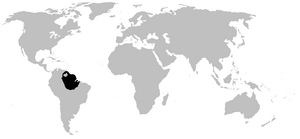Tukeit Hill Frog facts for kids
Quick facts for kids Tukeit Hill Frog |
|
|---|---|
| Conservation status | |
| Scientific classification | |
| Kingdom: | |
| Phylum: | |
| Class: | |
| Order: | |
| Suborder: | |
| Family: |
Centrolenidae / Allophrynidae
|
| Subfamily: |
Allophryninae
Goin, Goin, & Zug, 1978
|
| Genus: |
Gaige, 1926
|
| Species: |
A. ruthveni
|
| Binomial name | |
| Allophryne ruthveni Gaige, 1926
|
|
 |
|
| Distribution of A. ruthveni (in black) | |
The Tukeit Hill Frog (Allophryne ruthveni) is a small and unique frog. It is one of only two known species in its group, called Allophryne. The other species is named Allophryne resplendens. This frog is the only member of its special family group, the Allophryninae. Scientists recently placed this group under the larger Centrolenidae family.
These interesting frogs live in several countries in South America. You can find them in Guyana, Venezuela, Surinam, Brazil, and Bolivia. The very first Tukeit Hill Frog that scientists studied was found at Tukeit Hill in Guyana. This hill is located near the famous Kaieteur Falls. That's why the frog got its common English name, the Tukeit Hill Frog!
What Does the Tukeit Hill Frog Look Like?
The Tukeit Hill Frog is a small frog. It can have different colors and patterns. Some of these frogs are black. They have stripes and spots that can be shiny gold or a dull yellow color. Other Tukeit Hill Frogs have a dull yellow or golden belly. Their bellies are covered with black stripes and spots.
This frog has a body that looks quite flat. Its head is also small and flat. One of its unique features is its toe pads. These pads are large and wider than its fingers. They help the frog move around its environment.
Where Does the Tukeit Hill Frog Live and What Does It Do?
The Tukeit Hill Frog spends its time in two main places. It can be found low in the trees, usually about 1 to 3 meters (3 to 10 feet) off the ground. It also spends some of its time on the ground.
This frog prefers to live in forests where the trees are not too close together. It avoids areas where the land has been cleared. This means it likes places with some trees but not a very dense, thick forest.
See also
 In Spanish: Allophryne ruthveni para niños
In Spanish: Allophryne ruthveni para niños


